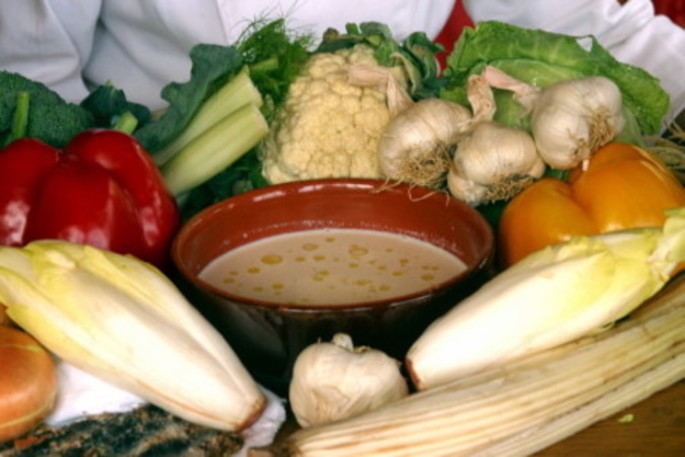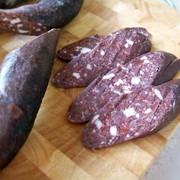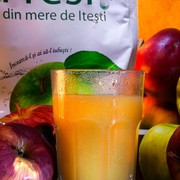Bagna caoda (or “bagna cauda” in the Italian spelling) is certainly the most famous dish of Piedmontese cuisine. Most important event is in Faule (little town near Torino and Cuneo)
Its name literally means “hot dip”: it is in fact a dip served warm in autumn and winter months, and eaten with raw, boiled or roasted vegetables.
Bagna caoda’s main ingredients, anchovies and garlic, give this dip its strong and pungent taste, which perfectly combines with vegetables like cardoon, carrot, peppers, fennel, celery, cauliflower, artichokes, and onions.
Among the many different versions diffused in the region, some feature butter, milk or cream to soften the taste. Others replace the olive oil with walnut or hazelnut oil, and around Alba truffle is also added to the dip.
Despite the many different versions, an established recipe was registered by the Asti delegation of the Accademia Italiana della Cucina in 2005. In this recipe each ingredient is measured per person, and there are strictly: one clove of garlic, half a glass of extra-virgin olive oil, 50 grams of Spanish red anchovies, and an optional bit of butter to be added in the end.
Originally served in a big pan called peila put in the centre of the table, bagna caoda is traditionally a dish to be shared. It is now more commonly served in little pots of terra cotta called diàn or fojòt, but its convivial use hasn’t changed.
The origins of this recipe are not totally clear. Being a dish consumed during the time of grape harvest, many suggest bagna caoda was prepared as a reward for grape-pickers for their work. The dip was in fact considered mainly a poor man’s dish, and it wasn’t accepted by aristocratic families, mostly due to the presence of garlic.
Bagna caoda can be matched with a full-bodied wine, such as Barbera, Nebbiolo, Barbaresco or Dolcetto.
Here are both the Academia’s recipe and a version with milk.
Academia’s recipe
Ingredients
6 cloves of garlic
600 g extra-virgin olive oil
300 g Spanish red salted anchovies
125 g red wine
Method
Peel and chop the garlic.
Put the anchovies in a bowl and cover with cold water. Let to rest for about 2 or 3 hours, changing the water regularly in order to desalinate them. Be delicate and make sure the anchovies stay intact.
Drain the anchovies. Cut them in half. Pull out the entrails and the fish-bone. Rinse and dry the fish, placing it on a tray covered with kitchen paper.
Put the anchovies in a bowl and cover them with red wine, stirring delicately. Then put the anchovies on the tray again.
Cook the garlic with 100 g of extra-virgin olive oil over low heat, always stirring. Add the anchovies and the rest of the oil. Keep cooking over low heat without boiling.
When the anchovies are softened, bagna caoda is ready to be served.
Version with milk
Ingredients
6 cloves of garlic
150 g extra-virgin olive oil
350 g fresh milk
300 g Spanish red salted anchovies
Method
Peel and chop the garlic.
Clean and desalinate the anchovies as described in the Academia’s recipe.
Cook the garlic with the milk until boiling, then keep on low heat for about 15-20 minutes, until the garlic has softened.
Heat half a glass of extra-virgin olive oil in a pot, and add the anchovies. Cook on low heat, stirring with a wooden spoon until the anchovies have softened.
Add the garlic paste to the pot with the anchovies and stir. Add the rest of the oil and cook for about 20-30 minutes, always on low heat.
To enjoy the bagna caoda, we suggest dipping roasted onions, boiled potatoes, roasted beetroot, raw peppers and carrots, and spring onions dunked in red wine like Barbera.















